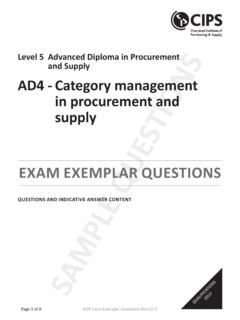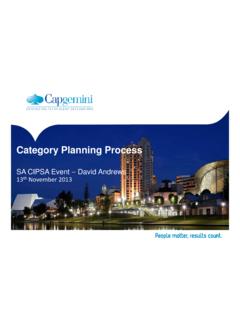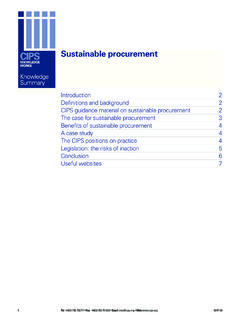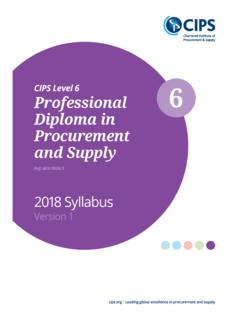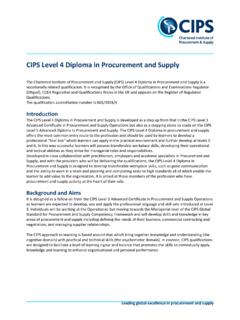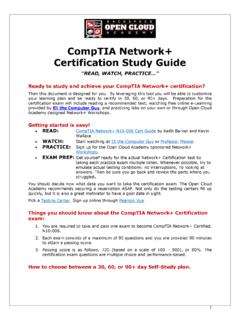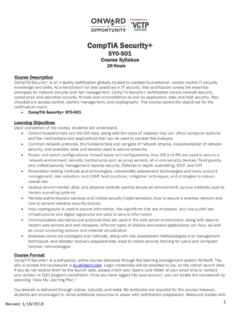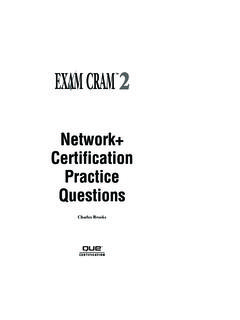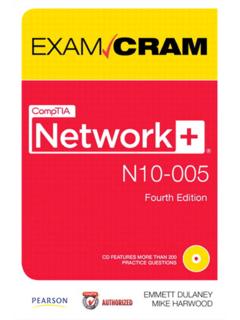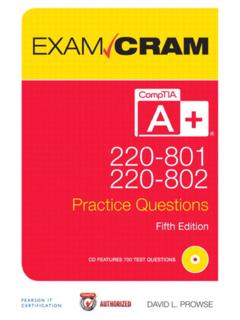Transcription of EXAM EXEMPLAR QUESTIONS - CIPS
1 SAMPLE QUESTIONSSAMPLE QUESTIONSPage 1 of 10 PD5 Exam EXEMPLAR QUESTIONS Mar2013 QUESTIONS AND INDICATIVE ANSWER CONTENTL evel 6 Professional Diploma in Procurement and SupplyPD5 - Programme and project management QUALIFICATIONS 2013 EXAM EXEMPLAR QUESTIONSSAMPLE QUESTIONSPage 2 of 10 PD5 Exam EXEMPLAR QUESTIONS Mar2013 QUESTIONS AND MARKING SCHEMEQ1 Learning outcome: Propose how the effective use of project management software can help an organisation manage its projects throughout each stage of the project life cycle. (25 marks)Marking scheme The question asks for a proposal, in other words a detailed point of view. Candidates could start their proposal with an outline at the most basic level, project management software can assist an organisation to manage projects from start to finish, and allow employees at different levels to have an input into the process. They could add that project applications can also carry out scheduling, cost control and budget management, resource allocation, collaboration, communication, quality management and documentation or administration.
2 The aim with these is to handle all aspects and complexities of larger projects and help keep costs down. However, the question requires a link to a stage process. During the first initiation stage of a project, software can be used to undertake contingency planning and what if analysis, allowing project managers to understand the effects of different scenarios. Project management software enables the various scenarios to be calculated relatively quickly and easily than would be the case manually. Information can be extracted to support the preliminary business case and the planning phase, project management software will also make project planning easier in that itwill allow the project manager to define the different activities that need to be can help in the production of detailed project planning documentation and has functions that would assist project managers in the planning of work scheduling. It will also help in the allocation ofresources, setting start and completion dates using network diagrams to show the critical path ofactivities and Gantt charts for resource the execution phase, the software could help in a number of ways.
3 Project managementsoftware is particularly helpful in handling complex projects. Re-planning can be done quickly, forexample, estimates may change during the project but project management software can producerevised schedules very quickly, and the changes can be reflected in the project plan changes to task lists will automatically create new schedules for the project. The softwarefacilitates resource planning which should enable the most effective use of the various resources,ensuring during project execution that there are the correct staff levels, equipment and material atthe right the project control phase, budget and control features of project software will assist inmonitoring and control. For example, actual costs can be quickly compared with budget costs, atboth the level of individual activity and for a project as a whole. This will encourage constanttracking of progress, since actual times can be captured and then comparisons made against plannedprogress enabling project managers to investigate any problem areas without delay.
4 The softwareallows both standard and tailored progress reports to be produced. The quality of thedocumentation will be high, and reports can be extracted and shared with the project team, andSAMPLE QUESTIONSSAMPLE QUESTIONS PD5 Exam EXEMPLAR QUESTIONS Mar2013 Page 3 of 10other interested the completion stage of the project life cycle, the software can be used to produce thecompletion report, since all information on costs and time will have been captured during the life ofthe project. The information held in the software can also be easily referenced to ensure all aspectsof the work scope have been should be noted that candidates may refer to alternative project life cycle model other than thefive stages outlined above but responses which are simply descriptive will not address all aspects of the addition, stronger responses might show extended study in this area by outlining that there are many good project management software applications available, (with Microsoft Project being one of the most popular) mid-range project management packages, and the likes of Primavera being popular at the higher end.
5 Often free and open source project tools are also available to download or use via a web browser. This type of additional input should be rewarded. (25 marks)CIPS study guide references: Chapter 3, section 4, page 40 onwards Chapter 4, section 3, page53 onwards SAMPLE QUESTIONSPage 4 of 10 PD5 Exam EXEMPLAR QUESTIONS Mar2013Q2 Learning outcome: (a) Analyse the Discounted Cash Flow (DCF) technique for appraising large investment decisions. (10 marks) (b) A car manufacturer has decided to make a significant investment into expanding its presence in Africa by setting up a large assembly facility in Kenya. It has estimated its initial set up costs to be in the region of Kenya Shillings 6,398M. Forecast net income from the project is detailed below: Year 1 Kenya Shilling 1,400M Year 2 Kenya Shilling 1,450M Year 3 Kenya Shilling 1,550M Year 4 Kenya Shilling 1,625M Year 5 Kenya Shilling 1,480M.
6 (i) Calculate the projected payback time for the project to the nearest month. (3 marks) (ii) Calculate the Net Present Value of the project using a discount factor of 5% and comment on the attractiveness of the project. Discount factors at 5% are; Yr 1 = , Yr 2 = , Yr 3 = , Yr 4 = , Yr 5 = (12 marks)Marking scheme (a) Discounted cash flow Candidates could start their analysis of this technique as this takes into account the time value of money. It is based on the principle that money is worth more than it is in the future. The principle exists for two reasons: Risk money in the future is uncertain. Opportunity cost money could be in an interest account earning interest. Discounting This is the process of adjusting the value of money from its present value to its value in the future.
7 The key to discounting is the rate of interest. The business chooses the most appropriate rate for the life of the project. It then identifies the discounting factor. The amount of money is then multiplied by the discounting factors to convert it to its net present value. Candidates are required to analyse DCF and should cover most of the following; DCF advantages Considers the time value of money Reducing discounting rate reduces future monies more heavily Only one method that gives a definitive answer Positive return it is worth QUESTIONSSAMPLE QUESTIONS PD5 Exam EXEMPLAR QUESTIONS Mar2013 Page 5 of 10 DCF disadvantages Time consuming More difficult to understand Based on an arbitrary choice of interest rate. Mention could also be made of the choice of discount factor and also the link of DCF with the IRR of a project. The above is certainly enough to score very well but the very best responses could demonstrate knowledge in this area by going on to say that the most widely used method of discounting is exponential discounting, which values future cash flows as how much money would have to be invested currently, at a given rate of return, to yield the cash flow in future.
8 Other methods of discounting, such as hyperbolic discounting, are studied in academia and said to reflect intuitive decision-making, but are not generally used in industry. The discount rate used is generally the appropriate weighted average cost of capital (WACC) that reflects the risk of the cash flows. The discount rate reflects two things: 1. The time value of money (risk-free rate) according to the theory of time preference, investors would rather have cash immediately than having to wait and must therefore be compensated by paying for the delay. 2. A risk premium reflects the extra return investors demand because they want to be compensated for the risk that the cash flow might not materialise after all. (10 marks) (b) (i) Payback period is 4 yrs and 3 months to nearest month any method acceptable. (3 marks) (ii) Net Present Value calculation ( Units are Kenya Shilling M) Yr 1 1400 x = 2 1450 x = 3 1550 x = 4 1625 x = 5 1480 x = Initial Inv present value Ken Shilling.
9 (9 marks)Comment:Whilst the project demonstrates a positive NPV the amount is extremely modest and represents just of the value of the initial investment. Further consideration and investigation of the project would be strongly recommended before decision to proceed. Stronger responses might comment on the impact of changes in economic factors that might warrant a different discount rate to be considered. (3 marks) CIPS study guide reference: Chapter 8, section 2 and 4 SAMPLE QUESTIONSPage 6 of 10 PD5 Exam EXEMPLAR QUESTIONS Mar2013Q3 Learning outcome: (a) Compare and contrast the project evaluation and review technique (PERT) with the critical path method (CPM). (15 marks) (b) Using the information in Table 1, assuming that the project team will work a standard working week (5 working days in 1 week) and that all tasks will start as soon as possible: TaskDescriptionDuration (Working Days)Predecessor/sARequirement Analysis5 BSystems Design15 ACProgramming25 BDtelecoms15 BEHardware Installation30 BFIntegration10C, DGSystem Testing10E, FHTraining/Support5 GIHandover and Go-Live5 HTable 1 (i) Determine the critical path of the project (3 marks) (ii) Calculate the planned duration of the project in weeks (3 marks) (iii) Identify any non-critical tasks and the float (free slack) on each.
10 (4 marks)Marking scheme (a) Candidates are required to compare and contrast, to examine one thing in relation to another so that points of similarity or difference become evident. The contrast element of the response should further highlight the key differences. PERT (Programme or Project Evaluation and Review Technique) and CPM (Critical Path Method) are specialised project management techniques and scheduling tools that allow managers to plan, manage and control complex tasks and projects. They are jointly referred to as network analysis, programming models, and critical path analysis (CPA) techniques, and although they are fundamentally different in their unique characteristics, they are usually used in conjunction with each other. PERT and CPM are used in various industries to effectively plan, organise and monitor project management related activities. PERT charts are management tools that facilitate effective decision making.
